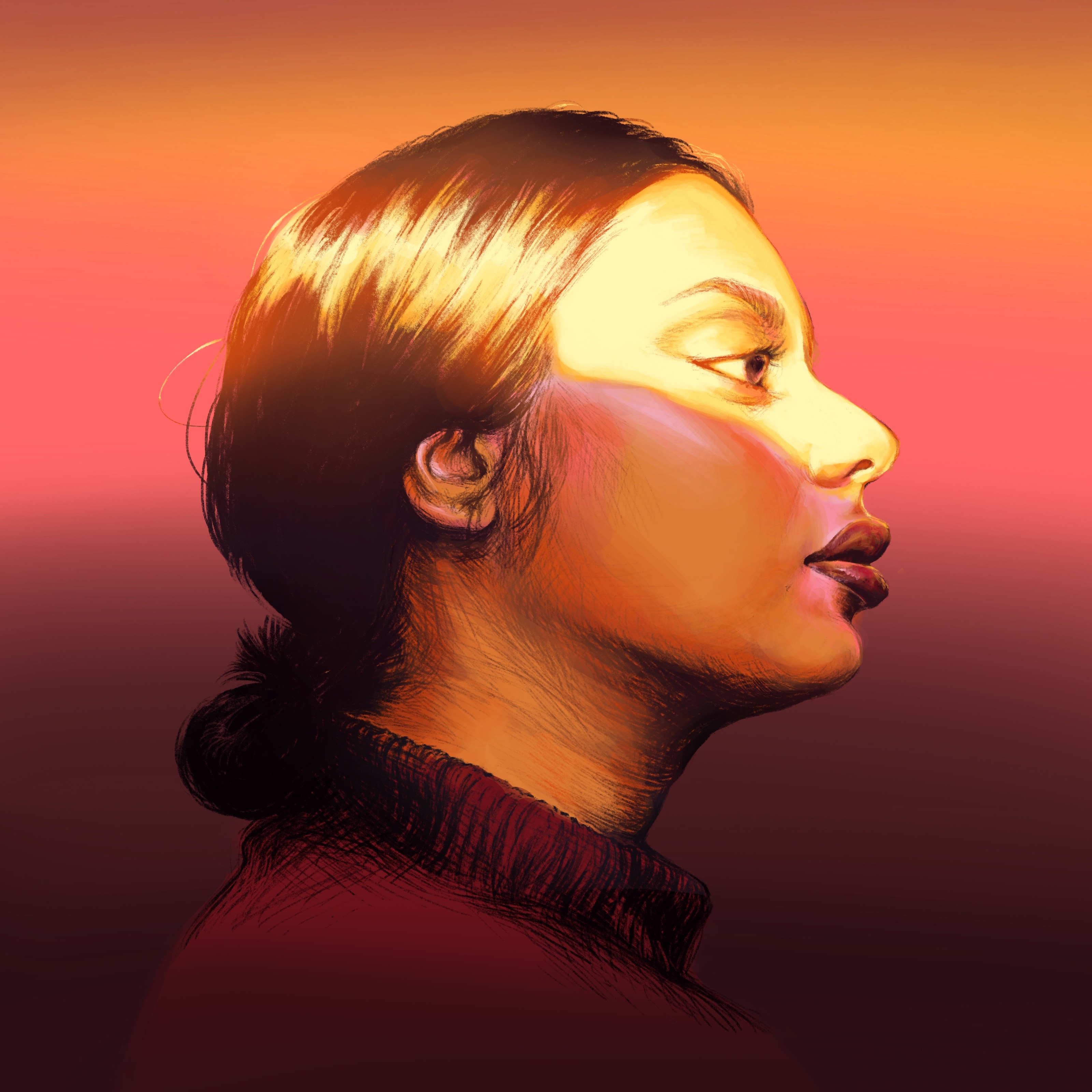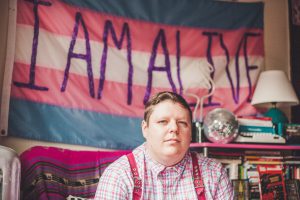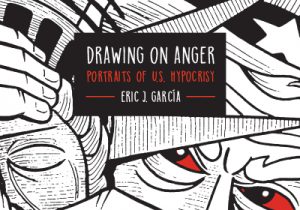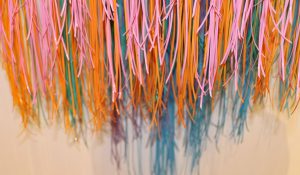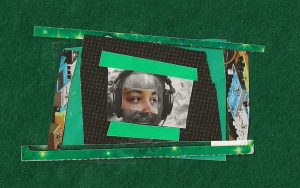Jenny Lam curates interactive and compelling exhibitions that spontaneously create community, bringing people together in fun and unexpected ways. Her 2012 exhibition I CAN DO THAT (named “Best Art Exhibit” by audience choice in NewCity’s 20th anniversary Best of Chicago issue) took on that often dismissive and frustrating phrase heard by many an artist at an opening and handed out art supplies for viewers to go ahead and try. Lam’s 2016 show LEXICON replaced the ubiquitous artist’s statement with blank paper for the audience to supply their own reactions. In 2020, she was all set to follow up these acclaimed shows with SLAYSIAN, a show celebrating Asian American artists from Chicago and the Midwest. And then the Covid-19 pandemic hit.
Even before Illinois’ shelter-in-place orders, Lam made the responsible decision to call off the public opening reception. But that doesn’t mean the end of the show. Since she couldn’t bring audiences to see the show in person, she brought SLAYSIAN directly to audiences, transforming it into an online exhibition we can view from the safety of our homes. It’s now available for us to click through in digital space, where we are free to take our time and linger over the amazing work of all the artists she brought together, including extra multimedia content that wouldn’t have been possible in a traditional physical exhibition space. She has also been creating community around the show by spotlighting artists from SLAYSIAN on social media. As Lam says on her website, “All of these artists’ work deserves to be seen far and wide. So until things get better (have hope; they will), here’s a digital exhibition.”
Corresponding over email, I talked to Lam about her motivations and inspirations for the exhibition, some of the difficulties (and silver linings) of converting a physical show into an online one, and how this exhibition endeavors to “serve as an act of resistance” in a time of resurgent anti-Asian racism.

Jennifer Patiño: How did the idea for the show come about? Why did you want to focus on Asian artists in Chicago and the Midwest in particular for this show?
Jenny Lam: In all my years of curating, I’d never curated an all-Asian show before (although I’d wanted to for a long time), and I’d personally never seen one either. I wanted to do something for the local Asian American community, to help give the artists a platform and expose them to a wide audience.
Growing up in the Midwest as an Asian American is such a big part of who I am, and yet I’d never incorporated that into my curatorial projects until now. And I’ve always been proud of who I am (being Chinese American, being the daughter of immigrants, etc. etc.).
(I have my parents and the way they raised me — and the way they still are in how we live our lives — to thank for this self-love. So, as a kid I belonged to two worlds: the one at home, where I spoke Cantonese and went all out for Chinese holidays and eagerly learned about our history and just as eagerly listened to my parents tell stories of their childhoods… and the world of school, the neighborhood, and everywhere else.)
People who don’t live here tend to have this image of the Midwest as being homogeneous when it comes to demographics and uncultured when it comes to the arts. We know that’s not the case, so I’ve always been all about showing us off. (When it comes to Asian Americans and art, if you just based your knowledge on national media coverage, you’d think California and New York were the only places in the country where both exist.) I’ve always believed in supporting the local, and in creating local opportunities.
There’s also something unique about the Midwestern Asian American experience (at least mine): As adults, we’ve found community, but growing up, in the world beyond our families, a lot of us were islands. I was the only Chinese kid in my grade in elementary school, and there were a handful of other Asian kids at most. In junior high my best friend was Pakistani, and she and I didn’t think about it like this at the time, that we were minorities or anything; all we knew was that we were drawn to each other, and that we shared so many similar values (particularly when it came to family and food!). It’s just different growing up as one of the only members of a group as opposed to other areas of the country where you might be surrounded by that group. It’s not worse or better — just different, and it shapes you.
And I have infinite Chicago / Illinois / Midwest pride. And I’m not alone in that; no one loves anything as much as Chicagoans love Chicago.

JP: This show has such a diversity of artists from many different backgrounds and working in a variety of mediums. Many of these artists also work in multiple genres and there is a theme of storytelling running through many of the pieces. Was this something you were looking to showcase? How did you choose the artists for the show?
JL: Funny enough, I actually wasn’t looking for any themes in particular!
So as I usually like to do, I put out an open call for artists. In the call I stated that there wasn’t a theme beyond featuring local Asian American artists, and that the artwork’s subject matter could be anything; the art didn’t have to be about being Asian in America (although if an artist’s work happened to already address that, that’s great too). I posted the call online, and it also spread through word of mouth. (It’s always neat to see an artist say something like “A coworker saw this and thought I’d be interested and told me about it.”)
(Five of the artists in the show I had reached out to personally, since I knew they were 1. artists; and 2. Asian. And of course I loved their work. But even then I had them submit their art like everyone else.)
From the applications I chose the artwork, and I made those selections before even reading the artists’ statements; that there turned out to be an underlying theme of storytelling is serendipity. It makes sense though; even if it’s not your intention, when you’re in America and you’re a person of color, or an immigrant or descendant of immigrants, or belong to any marginalized group, even if you just want to create something beautiful with no explicit ties to your identity (and I’m including myself as such an artist), it’s more likely than not that it will inform your art subconsciously.
JP: It takes a lot of resilience and care to move this show to an online medium and share it with those of us sheltering in place. Thank you for taking the time to do it. As a curator, what has been your experience of moving the show online during the COVID-19 pandemic? Has it shifted how you view the show?
JL: Thank you for saying that!
The first couple weeks of March, before postponing the show, I was growing more and more anxious and, honestly, scared with each passing day. Every day there’d be a new development in the news and I was getting worried about everyone’s safety. On March 12 (that wild day that included the NBA suspending the season among a whole year’s worth of headlines) I decided to make the public reception—since I usually love packing a space full of people and having a party-like atmosphere, and I definitely foresaw SLAYSIAN as being like that—into a private one just for the artists, a lowkey evening for them to meet each other, hang out, view each other’s art, and watch the scheduled performances. Then two days (and another two years’ worth of news) later I made the decision to postpone it all entirely. (That day I remember finding the jump in the number of new statewide COVID-19 cases alarming. That was also the day Governor Pritzker was practically begging folks to stay home for St. Patrick’s Day.)
I thought it’d be a tough decision, especially since I’d never made one like that before, but it honestly wasn’t; at that time I felt it would’ve been irresponsible of me to go ahead with an art show in the middle of all that was happening, and it felt pointless to have a private event when the artists deserve so much more than that. So I made the announcement postponing the show, and made a point of saying that it also meant I had (and still have) hope that things will get better. That was March 14, a week before Illinois finally sheltered in place. (And later I was so glad I made that decision then; the show would’ve opened on March 20, the night before the stay at home order began—could you imagine?)
That was all before the originally scheduled dates for artwork drop-off and installation, so I’ve actually never seen any of these pieces in person and can’t compare viewing them online versus seeing them in a gallery.

JP: In moving the exhibition online, was there anything you didn’t expect? What was the most difficult thing? Have you found anything that has been a silver lining? Can you tell us about the exclusive digital content?
JL: This sounds kind of silly, but the way the virtual exhibition is set up, there’s a preview image for each artist’s page, and I’ve also been spotlighting one artist per day on my social media, and when doing something like this online you have to think about what’s more eye-catching on a screen when someone’s scrolling quickly through their feeds and just what looks better as a cropped thumbnail, and it won’t always be in line with what my original favorite from each artist was (although fortunately a lot of times it is). I have to shift my mindset from the slower, more meditative experience of wandering into a physical space filled with art and being able to take it all in, to putting myself into the perspective of being in the digital world where it takes a split second before you lose interest and click on something else.
Also since we never had the artwork drop-off and installation, for most of these artists, I haven’t met them in person yet. So it’s funny; I’m well acquainted with their pieces, and I connected with the artists on social media for those who have it, but this is the first show where I can’t really associate each artwork with a face (minus a profile picture or something) and a voice and in-person personality. So that’s a little strange for me as someone who likes to go beyond the professional realm and consider my artists as friends.
The silver lining is definitely the endless “wall space!” There were some pieces some artists submitted that I loved so much but couldn’t include in the physical show because there simply wasn’t enough room. For instance, one of the artists, Saebom Yang, submitted some absolutely massive sculptures, my favorite of which measures 10 by 14 feet. So yes, now I have these pieces as bonus digital exclusives. If/when SLAYSIAN can go up as a physical show after all of this is over, those pieces won’t be on view in the gallery, so enjoy them now!
JP: For some of these artists, it is their first time being in an exhibition. Was it important for you to be able to feature artists sharing their work for the first time? If so, can you share why?
JL: One of the ways I strive for artist variety in my shows is the wide range of experience levels. It’s always fun to have emerging artists, to be there at the beginning of their journey. I feel honored whenever I find out that I was able to provide an artist with their first exhibition.
Even though I love the Chicago art community, if you go to enough gallery shows over the years, you tend to see the same names shown over and over again. For my exhibitions I always want to be like, Hey! There are all these other equally — if not more — talented artists that exist; they might not be big names [yet], but that doesn’t mean they shouldn’t be given a chance too.
And even though the Chicago art scene is relatively welcoming, it can be hard to break into when you’re starting out, unless you have the network. I speak from experience since I didn’t go to art school and, more importantly, didn’t go to art school here; I organically and gradually kind of pushed my way in. So this is me, on the other side, being that network for others.

JP: In your intro you talk about this show serving as an act of resistance, supporting artists of Asian descent amidst a resurgence of anti-Asian racism. What do you want visitors to the online exhibition to walk away with?
JL: I’ve always said that so often people consume culture or think they like a culture, but they don’t actually care about the people who created that culture. This can be reflected in small, subtle ways that don’t really seem to be a big deal, but expose a more overarching attitude. I used to use the example of photo series by Westerners of densely packed buildings in Hong Kong or lifeless cityscapes throughout Asia, but where were the close-up, humanizing portraits of the people living in those buildings and those cityscapes? (I love a cool architecture shot as much as anyone else, but when I travel, I make sure to also get to know folks, talk to them, listen to them, and yes, create portraits of them. To counter Sinophobia for example, I share my personal stories of beauty and kindness that I’ve experienced firsthand traveling in China.)
Similar to that example, these past couple months, when videos came out of residents in Wuhan opening their windows at night and shouting the equivalent of “Wuhan, stay strong!” to bolster each other’s spirits during their lockdown, I found it heartwarming and empowering, but then I’d see people here misinterpret the videos as being creepy and dystopian—then they’d react the complete opposite when Italians later did the same thing via song on their balconies, and now in Chicago with people doing those light shows in the Loop. In fact, there are plenty of uplifting stories about regular folks in China, but you don’t see those shared on mainstream Western media (or when they are, they aren’t presented as is and there’s some form of criticism injected in there); it doesn’t fit the narrative the West is trying to condition us to believe.
I’ve noticed that on the rare occasion when Asian Americans are in mainstream Western media, most of the time, it’s news where we’re victims of race-based violence. An endless barrage of misery and suffering can really take a toll, and your situation can seem hopeless. Of course these things must be reported on, but I also want to see stories of us experiencing joy and love, stories of us overcoming and achieving and thriving, stories of us just being. Art offers hope and a chance to feel something other than rage and despair.
One of the artists in the show, Aimy Tien, has in her artist statement that her work is driven by a concept by Viet Thanh Nguyen called “narrative plentitude,” which means there should be an abundance of stories so that no single story has to stand out to represent an entire group. Reading that in her bio was so interesting to me because it articulated something I’d intuitively been doing with SLAYSIAN; there are dozens of artists in this exhibition, each with differing dreams, desires, and beliefs — just as there is no singular way to be Asian American.
The onus shouldn’t be on the marginalized group to teach others that we’re, you know, actual human beings. Still, art cultivates empathy. Art can be used as a means for compassion and connection.
For those of us with the privilege to be able to stay home during this time, it’s the artists who are soothing your soul and keeping you occupied and helping you keep it together, from museums offering virtual tours of their collections to Yo-Yo Ma playing his Songs of Comfort. When I curate exhibitions, I strive to make them fun, accessible, and unpretentious (and there’s a little bit of humor and irreverence to them too); as was the case with my interactive shows like I CAN DO THAT and LEXICON, my goal is to always bring people together through art. SLAYSIAN is no different. You come for some levity, to check out some art by talented artists, and you just might leave inspired, motivated, and with a newfound sense of kinship and purpose towards this world we all live in.
Featured Image: Kristel Becares, Sunset Palette. A person with straight dark hair pulled into a low bun, viewed in profile from the neck up. The painting is captured in hues of purple, orange, and red, and the subject’s eyes are caught in a shaft of bright yellow light. Image courtesy of the artist.


Jennifer Patiño Cervantes grew up on the Southwest Side of Chicago with roots in Mexico. She is a community archives advocate and poet. She received her MSLIS at the University of Illinois at Urbana-Champaign and her BA in Art History from Columbia College Chicago with minors in Latinx Studies and Poetry. She is also a proud Spectrum Scholar.
